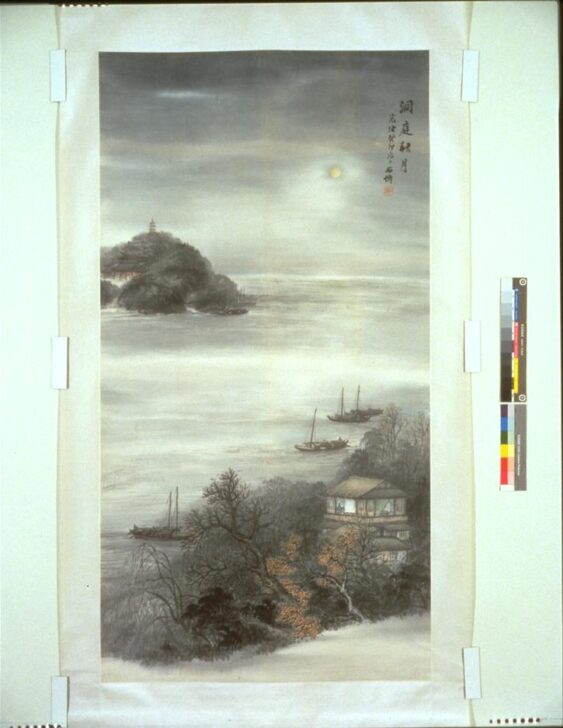Autumn Moon at Mt. Dongting
Wu Qingyun (Wu Ch'ing-yun)

Description
Inscription: Autumn Moon at Mount Dongting. Summer, 1903. Shixian
Seal of the artist
A Shanghai artist of the early twentieth century, Wu Qingyun uses dark, wet ink wash and light accents of color to capture the lyrical mood of an autumnal moonlit night at Lake Tai and Mount Dongting. Having traveled to Japan, Wu appears to have been aware of both Japanese art and European Impressionism, expanding his artistic vision. Up close the boats appear as freely brushed lines and yet at a distance, their forms come into focus. This subtle use of loose brushwork suggests impressionism, marking the beginning of a new phase in the development of Chinese painting.
----
A Shanghai artist of the early twentieth century, Wu Qingyun uses dark, wet ink wash and light accents of color to capture the lyrical mood of an autumnal moonlit night at Lake Tai and Mount Dongting. Having traveled to Japan, Wu appears to have been aware of both Japanese-and European-style painting, drawing upon these to expand his artistic vision. Up close the boats appear as freely brushed lines, and yet at a distance, their forms come into focus. This subtle use of loose brushwork suggests Impressionism, marking the beginning of a new phase in the development of Chinese painting.
(Chinese Gallery Rotation, Fall 2010)
Gallery Rotation Fall 2010
Wu Qingyun
China, 1845–1916
Autumn Moon at Mt. Dongting
Qing Period (1644–1912)
1903
Hanging scroll, ink, and light color on paper
Gift of John Schloss, 1998/2.7
A Shanghai artist of the early twentieth century, Wu Qingyun uses dark, wet ink wash and light accents of color to capture the lyrical mood of an autumnal moonlit night at Lake Tai and Mount Dongting. Having traveled to Japan, Wu appears to have been aware of both Japanese-and European-style painting, drawing upon these to expand his artistic vision. Up close the boats appear as freely brushed lines, and yet at a distance, their forms come into focus. This subtle use of loose brushwork suggests Impressionism, marking the beginning of a new phase in the development of Chinese painting.
Subject Matter:
A Shanghai artist of the early twentieth century. Having traveled to Japan, Wu appears to have been aware of both Japanese-and European-style painting, drawing upon these to expand his artistic vision. Subtle use of loose brushwork suggests Impressionism, marking the beginning of a new phase in the development of Chinese painting.
Physical Description:
Dark, wet ink wash and light accents of color capture the lyrical mood of an autumnal moonlit night at Lake Tai and Mount Dongting. A round moon hangs low in the sky at top right, with a diffuse glow slightly brightening the clouds and sky below. Two islands sit in the water below, the larger (closer) of the two has four boats moored just offshore. Up close the boats appear as freely brushed lines, and yet at a distance, their forms come into focus. A building sits on the closer island, light shining in the windows. The silhouette of a pagoda can be seen on the further island.
Usage Rights:
If you are interested in using an image for a publication, please visit https://umma.umich.edu/request-image/ for more information and to fill out the online Image Rights and Reproductions Request Form.